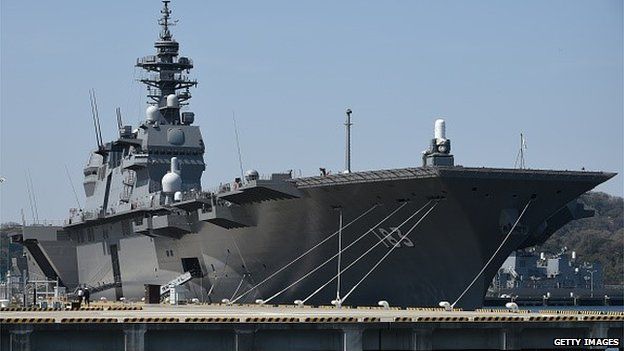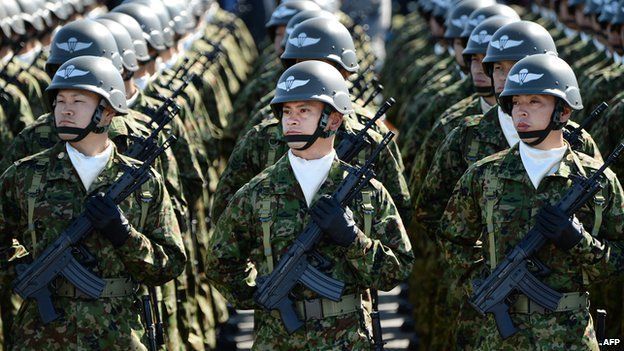Japan's (self) defence forces
By Jonathan Marcus
The impassioned debate surrounding Prime Minister Shinzo Abe's desire to give Japan's defence forces a wider role obscures the fact that the country is already a significant military player. It has well-equipped air, sea and land forces with ambitious modernisation plans under way.
The defeat of Japanese militarism in World War Two and the experience of suffering the world's only atomic bomb attacks left the country with a deep vein of pacifism. But Japan's strategic geography - proximity to both the then-Soviet Union and China - meant that it ultimately needed to deploy its own basic defence forces. Their role though was heavily circumscribed and Japan avoided all foreign military entanglements.
Some 70 years later, the picture has changed dramatically. The Cold War may be over and the Soviet Union no more but now a rising China is driving security concerns in the region.
Japan remains the United States' key ally in the region. And with the scale and reach of China's military growing significantly, Japan has been modernising its own forces.

Chinese driver
Its army of some 150,000 troops is small (but still larger than that of Britain, one of Nato's middle-ranking players whose forces stand at some 84,000).It has an impressive navy including a small helicopter carrier, two Aegis-equipped cruisers with sophisticated radars and battle management systems, and some 34 destroyers and nine frigates of various types. It also has some 80 anti-submarine warfare or maritime patrol aircraft.
Given the potential threat from North Korea's missile arsenal, Japan has a growing interest in ballistic missile defence.
The country hosts two highly sophisticated US radars to track such weapons. It currently has four destroyers capable of shooting down ballistic missiles along with land-based PAC-3 missile interceptors. More are planned.
But above all it is China's widening security horizons that are driving Japan's military modernisation.
This year, Japan's Maritime Self-Defence Force commissioned its largest vessel yet - a new helicopter carrier - the JS Izumo. This could potentially embark a number of V-22 Osprey vertical lift aircraft - and Japan is thought to be interested in buying up to 17 of them from the United States.

Foreign exercises
Over the years, Japan has also widened its sphere of international military activities. It's been a slow process with the country dipping its toes slowly into the field of foreign entanglements.But Japanese warships have participated in international anti-piracy operations off the Horn of Africa and Japanese maritime patrol aircraft have supported this mission from Djibouti.
Japan has also slowly begun to take part in military exercises further from its shores. In July 2014, it participated for the third time in joint US-Indian naval manoeuvres and a small contingent of Japanese troops is currently involved in the joint US-Australian Talisman sabre exercise.
So in many ways the sorts of reforms being pushed by Prime Minister Abe have already been under way - little by little - for many years.
Nonetheless, making the changes explicit raises strong passions among the Japanese public, and any perceived revival of Japan as a military player prompts strong reactions from those who have suffered from its military expansionism in the past - notably China.
What is collective self-defence?

Mr Abe's government has pushed for a change that would revise the laws such that Japan's military would be able to mobilise overseas when these three conditions are met:
- when Japan is attacked, or when a close ally is attacked, and the result threatens Japan's survival and poses a clear danger to people
- when there is no other appropriate means available to repel the attack and ensure Japan's survival and protect its people
- use of force is restricted to a necessary minimum
In the maritime sector, defence must be forward - beginning far from a country's own shores. Japan's defence depends fundamentally upon its close alliance with the United States and thus it makes sense for Japan's armed forces to operate according to similar concepts and strategic parameters.
This though is to overlook the huge weight of history in the region - a burden made even heavier by suspicions among some countries that Japan has not really fully come to terms with its aggressive past.
Whatever the statements of some more conservative Japanese politicians, the anguished debate over the country's changing strategic posture would suggest that many ordinary Japanese are all too well aware of their history which makes Mr Abe's path a bumpy one to say the least.


0 Comments:
Post a Comment
Subscribe to Post Comments [Atom]
<< Home